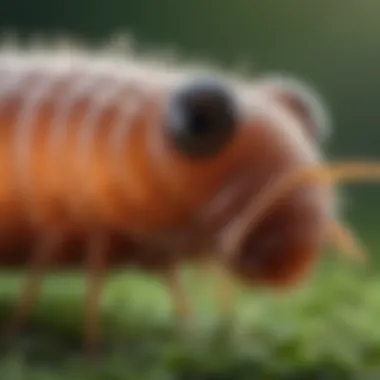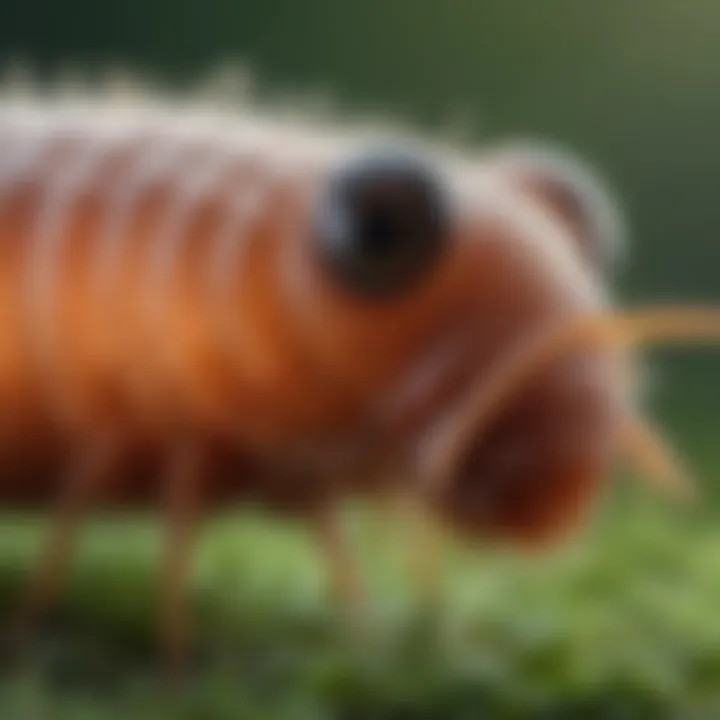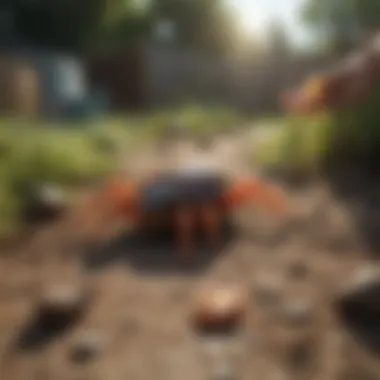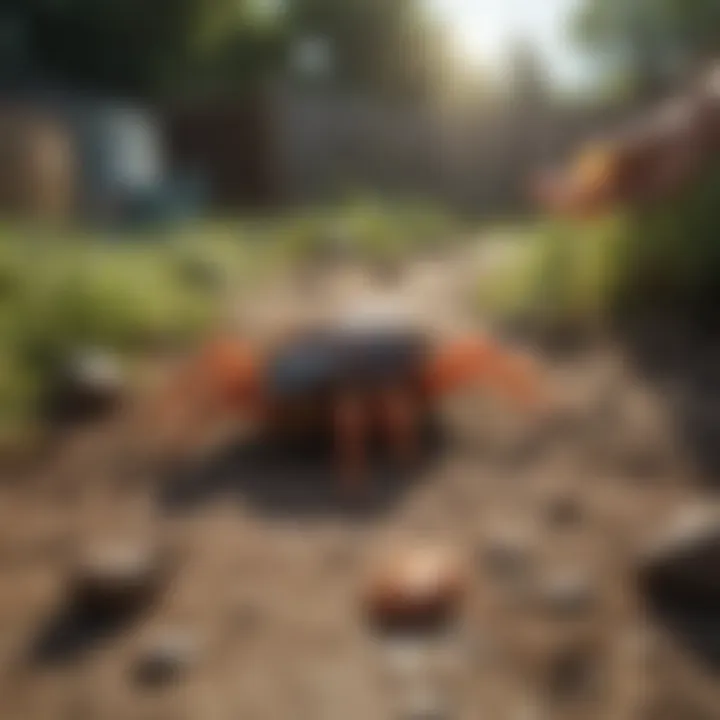Home Remedies for Managing Chigger Infestations


Intro
Chiggers, those tiny, almost invisible mites, can turn a peaceful day outdoors into a scratching frenzy. These pests are more notorious than one might think, especially during the warmer months. What might seem like a simple itch can lead to discomfort, sleepless nights, and more. Understanding how to identify, prevent, and treat these infestations can be a game changer for every homeowner. It’s not just about enduring; it's about reclaiming your space and peace of mind.
Pest Identification
Detailed descriptions of common pests
Chiggers belong to the family Trombiculidae and are most commonly found in grassy, wooded, or rural areas. These minuscule creatures are typically red or orange, often resembling small specks. Adult chiggers are not the issue; it's their larvae that latch onto humans and animals, feeding on tissue fluid, leading to the infamous itching. Knowing what these creatures look like is the first step in prevention.
Signs and symptoms of infestations
Identifying a chigger infestation isn't always straightforward. Homeowners often associate chigger bites with red, itchy welts that can appear several hours after exposure. Common signs include:
- Red, raised spots on the skin, often grouped in clusters
- Intense itching, primarily at night
- Signs of discomfort from pets or other animals, which may also be affected
When you notice these symptoms, especially after spending time outdoors, it’s essential to take immediate action.
Prevention Strategies
Home maintenance tips for pest prevention
To keep chiggers at bay, maintenance around the home is crucial. Consider these practices to reduce chigger populations:
- Mow your lawn regularly: Cutting the grass short reduces chigger habitats.
- Remove leaf litter and debris: This provides a less inviting environment for these pests.
- Creating barriers: Gravel or wood chip borders around gardens can help limit their access.
Natural deterrents and barriers
Some natural methods can also help fend off these uninvited guests. Essential oils such as lemon eucalyptus and tea tree oil have repellent properties. Using these in a diluted form and spraying them in your yard creates a natural barrier. Also, wearing longer clothing can mitigate direct contact when venturing into grassy areas.
Treatment Options
Overview of chemical vs. natural treatments
When they do find a way in and the itching starts, understanding treatment options becomes paramount. Both chemical and natural treatments are available; however, choosing depends on personal preferences and the severity of the infestation.
- Chemical treatments: Offer quick relief and include sprays containing permethrin or pyrethroids. Always follow the instructions for safe use.
- Natural treatments: Include rubbing alcohol or baking soda paste. These can alleviate itching but may take longer to work.
Step-by-step guides for DIY treatments
Here’s how you can tackle those pesky bites:
- Clean the affected area: Gently wash with soap and water. This helps reduce the chance of infection.
- Apply a cool compress: This soothes itching and reduces inflammation.
- Use topical treatments: Apply calamine lotion or hydrocortisone cream for itch relief.
For a natural remedy, mix baking soda with water to create a paste, applying it directly to the bites, which can help with itching and promote healing.
Remember: Act promptly to manage bites. The sooner you treat the itching, the less likely you'll contribute to your discomfort.
Finding effective ways to manage chigger infestations at home is not just about mitigation; it’s about empowerment. By understanding these pests, employing preventive methods, and knowing how to treat infestations when they occur, you can restore comfort in your living space.
Understanding Chiggers and Their Habitat
Understanding chiggers and their habitat is crucial for effectively managing infestations and reducing the likelihood of bites. While many people may be familiar with chiggers, few grasp the intricacies of where they thrive and how to mitigate their presence. A comprehensive look at their behavior and habitat can empower homeowners in the fight against these tiny pests.
What Are Chiggers?
Chiggers are the juvenile stage of certain mite species, primarily from the Trombiculidae family. Despite their common mislabeling as insects, these organisms are arachnids, more closely related to spiders and ticks. Chiggers are often hardly visible to the naked eye, measuring only about one-fourth of a millimeter, but their presence can trigger intense itching and discomfort. They latch onto hosts, like humans and animals, to feed on skin cells, which leads to the hallmark symptoms of their bites.
Life Cycle of Chiggers
The life cycle of chiggers encompasses four distinct stages: egg, larva, nymph, and adult. The journey begins when a female lays hundreds of eggs in the soil or on vegetation. After hatching, the larvae emerge and seek out a host for a blood meal, attaching to skin typically in areas where clothing affixes tightly to the body, like around the ankles or waist. After feeding, which lasts a few days, the larvae then fall off and undergo a transformation into nymphs. This stage does not feed on humans. Eventually, they develop into adults, capable of reproducing, and the cycle continues. Understanding this cycle is vital for targeting interventions at the right phase to prevent further infestations.
Common Habitats for Chiggers
Chiggers prefer warm, humid environments where they can thrive undisturbed. They often reside in tall grasses, wooded areas, and gardens rich with dense foliage. Patches of unkempt lawn or vegetation are prime real estate for these pests, providing ample opportunities for them to latch onto unsuspecting animals or humans that brush past.
"Chiggers are especially drawn to moisture, making places where ground level is damp or shaded particularly susceptible to infestations."
Identifying and understanding these habitats can help strategize preventive measures, such as regular yard maintenance or using barriers to limit exposure when entering high-risk areas.
Employing knowledge about chigger behavior and their preferred habitats not only aids in avoiding their bites but also sets the foundation for informed treatments and long-term pest management strategies.


Identifying Chiggers
Recognizing chiggers is crucial for homeowners. These tiny critters can swiftly become a hassle if left unchecked. Knowing how to identify them can help in taking prompt action. When you determine you have a chigger problem early on, it can save you time, discomfort, and potential expenses associated with larger infestations. If you’re aware of what to look for, it’s easier to start treatments before more damage is done or bites occur.
Physical Characteristics
Chiggers are notoriously hard to spot due to their minuscule size. They are typically less than 1/150th of an inch in length, and their red or orange hue sometimes blends in with the surrounding grass and foliage. Here are their most noticeable features:
- Color: Adults appear bright red or orange, while younger stages are more transparent.
- Shape: They have a distinct, rounded body which might remind you of a speck of red dust.
- Legs: Chiggers have six legs in their larval stage and eight in their adult form, giving them a unique appearance compared to other mites.
- Movement: You may spot them moving quickly across surfaces, almost resembling a tiny dot darting about.
Understanding these characteristics helps you to quickly identify whether you have chiggers in your yard or home. Remember, they don’t fly or jump—most of their movement is a crawl, so any tiny creature that seems to appear out of nowhere could potentially be a chigger.
Signs of a Chigger Infestation
Identifying an infestation goes beyond spotting the creature itself. Some key indicators can alert you to the presence of chiggers in your living space:
- Unexplained Itching: If you notice itchy, red welts on your skin, especially after spending time outdoors, chiggers might be the culprits. This can often happen just hours after exposure.
- Bite Patterns: Chigger bites usually form in clusters or lines, which can resemble other types of insect bites but are distinct in their clustered nature. You might find bites in areas where clothing fits tightly, like around waistbands or socks.
- Increased Presence of Wildlife: If your yard has higher rodent activity or other wildlife, it could be a breeding ground for chiggers. These pests thrive where small mammals, their primary hosts, are prevalent.
- Visible Egg Masses: On rare occasions, you might even see small, whitish clusters near areas where the grass is densest. This could indicate a breeding site below the surface.
It's crucial to act swiftly once you identify these signs. Ignoring them may lead to discomfort and larger infestations.
By keeping these signs in mind, you can take the necessary steps to treat and prevent chigger infestations effectively. The sooner you identify them, the better prepared you'll be to handle any nuisance they may cause.
Health Risks Associated with Chigger Bites
Understanding the health risks linked to chigger bites is crucial for homeowners looking to protect themselves and their families. Chiggers may seem like just a nuisance, but they can lead to various health concerns that could escalate if not addressed properly. Homeowners often underestimate the impact of these tiny pests, which can cause intense itching and even more severe allergic reactions.
An effective approach to managing any pest starts with awareness. Knowing the potential health risks can help people stay vigilant and responsive, ensuring they take steps to minimize exposure and treat bites effectively. Chigger bites are not merely itchy; they can affect daily living and lead to secondary infections if proper care is not taken. Let’s delve deeper into the symptoms and complications arising from chigger bites.
Symptoms of Chigger Bites
Chigger bites can often be identified by certain symptoms, which are pivotal in distinguishing them from other insect bites. The initial symptoms usually manifest as:
- Intense itching: Perhaps the most notorious symptom, the itching begins within hours of the bite and intensifies over time.
- Red welts or bumps: Affected areas may develop raised, red spots, often resembling hives.
- Inflammation: Swelling around the bite site can occur, adding to discomfort.
The itching is due to chiggers' saliva, which contains enzymes meant to break down skin cells for feeding. For some, the discomfort can feel like a bad case of poison ivy. It’s essential to note that while the itching may seem trivial, it can lead to ongoing irritation and distress.
If left unchecked, scratching the bites can lead to additional issues. Following are some points that highlight how important it is to remain aware of one's symptoms:
- Duration: Symptoms typically linger for a week or so, but persistent scratching can elongate the process.
- Allergic reactions: In susceptible individuals, chigger bites may trigger unusual allergies, causing heightened skin irritation or systemic symptoms.
- Secondary infections: Breaking the skin through scratching opens doors for bacterial infections.
Potential Complications from Bites
Most chigger bites will heal on their own without any major health implications. However, there are potential complications that can arise, particularly if bites are not treated promptly or if excessive scratching occurs. Here are few complications to be cautious of:
- Bacterial infections: If the skin barrier is compromised, bacteria can enter, leading to infections like cellulitis or impetigo.
- Severe allergic reactions: Some individuals may experience extreme allergic responses, which could necessitate medical intervention.
- Persistent skin changes: In rare cases, individuals may develop a rash or sensitivity that lasts well beyond the initial bite period.
"Awareness is the first step in effective pest management. Don't just brush aside a chigger bite; it could lead to bigger troubles."
Regularly checking for bites and implementing prompt home treatments can drastically reduce these risks. It’s all about staying informed and prepared.
Preventing Chigger Infestations
Preventing chigger infestations is not just important; it’s essential for maintaining comfort and peace in your home. Chiggers can easily infiltrate personal spaces, leading not only to discomfort from bites but also to potential health risks associated with scratching and irritation. Having a well-structured prevention plan significantly reduces the chances of these pesky pests taking up residence.
It’s essential to approach prevention from both outdoor and indoor perspectives, as these locations present different challenges and strategies. Let’s delve into effective techniques for both environments to equip you with the knowledge needed to keep your living space chigger-free.
Outdoor Prevention Techniques
When it comes to outdoor areas—especially yards, gardens, and any grassy knolls—effective prevention is pivotal. Here are several approaches to create a chigger-resistant environment:
- Maintain Your Lawn: Regularly mowing the grass not only keeps your property looking neat but also diminishes the chigger habitat. Short grass does not provide ample hiding spots for them.
- Control Weeds and Tall Vegetation: Weeds are a haven for chiggers. Keeping these in check decreases their likelihood of establishing a foothold near your home.
- Create Physical Barriers: Consider installing mulch or gravel around flower beds. These barriers not only improve aesthetics but also disrupt the movement of chiggers toward your home.
- Water Management: Chiggers thrive in moist areas. Make sure to address any drainage issues, and avoid overwatering your gardens, as this can create ideal conditions for chigger populations.
- Natural Predators: Introducing or encouraging natural predators, such as birds and certain insects, can help keep chigger numbers in check. Planting flowers that attract these beneficial creatures can work wonders.
Keeping your outdoor areas tidy and well-maintained is fundamental in preempting chigger infestations.
Indoor Prevention Techniques
Once chiggers make their way inside, they can be challenging to eliminate. Here are tactics to prevent their entry and establishment indoors:
- Seal Cracks and Gaps: Inspect door frames and window sills for any openings. Repairing these not only keeps chiggers out but also contributes to overall energy efficiency.
- Regular Cleaning: Frequent vacuuming is critical. Ensure you focus on corners, under furniture, and any other areas where dust settles. Chiggers can hitch a ride on pets or clothing, so thorough cleaning prevents indoor infestations.
- Control Humidity Levels: Chiggers thrive in humid conditions. Using dehumidifiers or air conditioning can help create an environment less favorable for chiggers.
- Pet Care: Regularly bathe and groom pets, as they can carry chiggers into your home. Flea and tick prevention can help immensely.
- Educate Family Members: Make sure everyone in your household knows what chiggers are and where they may lurk, so they can help in spotting signs of their presence and taking preventive action promptly.
Adopting these practical measures can significantly lower the risk of chiggers invading your home. A proactive approach is your first line of defense against these unwelcome intruders.
Home Remedies for Treating Chigger Bites


When chiggers make their presence known, their bites can lead to intense irritation, often causing scratching that further aggravates the skin. For many homeowners, finding effective home remedies to mitigate the discomfort of chigger bites is crucial. With natural agents available in many households, these remedies can provide immediate relief without the need for a trip to the pharmacy. Understanding these options can empower individuals, enabling them to respond swiftly to chigger bites and reduce associated symptoms without resorting to harsh chemicals. Home remedies not only address itchiness but can also soothe inflamed skin and promote healing.
Natural Soothing Agents
There are numerous natural ingredients known for their soothing properties. Here are some of the most commonly used remedies:
- Aloe Vera: A staple in many gardens, aloe vera is famous for its cooling, anti-inflammatory properties. Applying its gel directly onto bites can provide instant relief.
- Oatmeal: A mixture of colloidal oatmeal with water creates a paste that can alleviate itchiness. It can create a moisturizing barrier while calming the irritated skin.
- Tea Tree Oil: Known for its antiseptic qualities, tea tree oil can also soothe soreness when mixed with a carrier oil prior to application.
- Baking Soda: A simple baking soda paste made by mixing the powder with a little water can be spread over bites to reduce itching and swelling.
- Apple Cider Vinegar: This kitchen staple can be diluted with water and dabbed onto the skin. It is believed to restore the skin's pH balance and reduce inflammation.
Using these agents appropriately can make a significant difference in managing the discomfort caused by chigger bites. It's essential to consider individual skin sensitivities, and perhaps perform a patch test to ensure no adverse reactions.
Application Techniques for Home Remedies
Once you’ve chosen your remedy, applying it correctly is key to achieving the desired results. Here are some effective techniques:
- Clean the Area: Start by washing the affected area gently with soap and water. This helps remove any irritants and reduces the chance of infection.
- Apply the Remedy: Depending on the remedy:
- Allow Time to Work: Give the home remedy some time to take effect. However, if irritation or redness worsens, it’s wise to rinse it off and consider other options.
- For aloe vera, simply squeeze some gel onto the bite and let it absorb.
- For a baking soda paste, apply it gently and let it dry before rinsing.
- Diluted tea tree oil should be applied with a cotton ball to avoid overwhelming the skin.
Always observe how your skin reacts to natural remedies, as individual reactions may vary.
- Reapply as Necessary: Depending on the remedy and level of discomfort, reapplication may be required. Monitor how your body responds to gauge when it's time to apply a new layer.
- Avoid Scratching: While it can be tempting, refrain from scratching the bites as this may lead to further irritation or infection.
Implementing these home remedy techniques can provide significant relief from chigger bites. Coupled with prevention methods and awareness, homeowners can better manage and reduce the discomfort associated with these pesky pests.
Over-the-Counter Treatments
When dealing with the vexing issue of chigger infestations, over-the-counter treatments often serve as the first line of defense for many homeowners. These readily accessible products provide quick relief from the itching and discomfort associated with chigger bites. Most importantly, they are easy to use and can effectively alleviate symptoms without the need for a doctor’s visit.
Topical Anti-itch Creams
Topical anti-itch creams are a go-to solution for soothing the irritation that comes from chigger bites. These creams typically contain ingredients such as hydrocortisone or calamine lotion. Hydrocortisone cream works by reducing inflammation and itching, while calamine lotion gently cools the skin, offering immediate comfort. Applying a thin layer directly onto the affected area can noticeably decrease the discomfort. Here’s a simple method:
- Clean the area with mild soap and water.
- Pat dry gently with a towel, avoiding any scratching.
- Apply the cream, spreading it out evenly over the bite.
- Reapply every few hours as needed, based on the product instructions.
An essential tip: always check the expiry date on these creams. Using outdated products can diminish effectiveness.
Oral Antihistamines
Oral antihistamines are another effective option in the battle against chigger bites. These medications work by blocking histamine receptors that trigger allergic reactions in the body, which is the primary cause of itchiness and discomfort. Over-the-counter options like diphenhydramine (commonly known as Benadryl) or cetirizine (Zyrtec) can help alleviate the systemic symptoms associated with chigger bites.
For best results, you can follow this guidance:
- Read the dosage instructions carefully to avoid any adverse effects.
- Take the antihistamine before bedtime if it causes drowsiness, allowing you a more restful night without scratching.
- Know your options: some antihistamines might cause sleepiness, while others might not, so choose the one that fits your daily activities better.
"Using the right over-the-counter treatments can mean the difference between a peaceful night and a long, uncomfortable one!"
By being proactive and educated about chigger treatments, homeowners can maintain their comfort and tackle infestations head-on.
When to Seek Professional Help
Chigger infestations, while often manageable with home treatments, can sometimes escalate beyond simple remedies. Recognizing when to seek professional help is crucial for effectively addressing an outbreak that could potentially lead to severe health issues. Ignoring a worsening situation can result in complications, not just with chigger bites but also secondary infections due to excessive scratching. Thus, understanding the signs that necessitate a visit to a healthcare provider becomes vital.
Identifying Severe Reactions
Not every chigger bite results in serious consequences, but certain symptoms can signal the need for immediate medical attention. Here are some indicators:
- Intense Swelling or Rash: While swelling is common due to a chigger bite, excessive swelling or an expanding area of redness should raise a red flag.
- Persistent or Severe Pain: If the itching or discomfort escalates to levels that disrupt daily activities, it might be more than just an ordinary bite.
- Signs of Infection: Watch for pus or increased warmth in the area around the bite. These can be signs that the area is infected, requiring antibiotic treatment.
- Breathing Difficulties or Allergic Reactions: Rarely, individuals may develop allergic reactions leading to hives or even trouble breathing. This is a medical emergency and requires immediate attention.
For most people, chigger bites will heal without complications, but staying vigilant is key.
Consulting Medical Professionals
When confronted with the aforementioned severe reactions, consulting a medical professional cannot be overstated. Not only can they assess the bite’s severity, but they can also offer targeted treatments that might be unavailable over-the-counter. Here are areas where professionals can provide vital assistance:
- Prescription Medications: For extreme cases, especially with severe itching or risk of infection, a healthcare provider can prescribe stronger topical ointments or oral medications.
- Allergy Testing: If an allergic reaction is suspected, immunology consultations may help identify specific allergens and provide guidance on avoiding them in the future.
- Skin Care Plans: For recurring issues or those at risk for skin infections, dermatologists can establish tailored care routines that may help alleviate future infestations.
- In-depth Consultations: Sometimes, the context of the infestation suggests larger ecological issues that require specialized knowledge. Exterminators can offer detailed insights into local pest behavior.
In summary, while it’s often possible to treat chigger issues at home, knowing when to seek professional help is crucial. Early intervention can prevent complications and ensure swift relief from discomfort.
Chemical Treatments for Chigger Control
When dealing with chigger infestations, sometimes the most effective approach is to reach for chemical treatments. While many might prefer natural remedies, understanding the role of chemicals in extermination can bring peace of mind and quicker relief. Using insecticides can significantly reduce the chigger population in your immediate environment, helping to prevent further bites and discomfort.
Chemical treatments effectively combat chiggers by disrupting their life cycle. This highlights their potency in managing infestations. One of the core benefits of chemical interventions is their swift action. In most cases, applying the right insecticide can drastically lower the number of chiggers within hours, allowing you to reclaim your space without prolonged discomfort. However, this option shouldn’t be taken lightly; it involves careful consideration of safety measures and environmental impact.


Additionally, combining chemical treatments with other strategies—like preventative measures—can provide a well-rounded approach. Homeowners should weigh their options, as sometimes the quickest fix may not align with personal preferences regarding environmental stewardship or chemical exposure. This section delves into the specifics of the types of insecticides available and highlights essential precautions to follow during application.
Types of Insecticides
Various products on the market claim efficacy against chiggers. Here are some commonly used:
- Permethrin: A synthetic chemical derived from chrysanthemums, it's widely used for treating clothing, mosquito nets, and outdoor areas.
- Malathion: This organophosphate insecticide works by affecting the nervous system of chiggers and is typically applied in yards or gardens.
- Bifenthrin: Often used for its residual effect, bifenthrin can provide lasting protection against chigger populations in treated areas.
- Carbaryl: Known for its quick action, this insecticide is suitable for immediate application in infested spaces.
While these products are effective, it’s vital to read labels carefully. Different formulations have specific uses, optimal environments, and the pests they target. Always choose an insecticide labeled specifically for chiggers to ensure effectiveness.
Application Safety Precautions
Before diving into applying insecticides, it’s essential to prioritize safety. Here’s a handy checklist to ensure the process is secure:
- Read Instructions: Each product comes with guidelines— adhere strictly to these.
- Wear Protective Gear: Gloves, masks, and long-sleeved clothing can shield skin and minimize inhalation of fumes.
- Avoid Windy Days: Applying pesticides during windy conditions can lead to cross-contamination or unintended exposure.
- Keep Pets and Children Away: Ensure that play areas are clear of pets and kids during and immediately after application.
- Ventilate Spaces: For indoor treatments, open doors and windows to promote airflow.
Long-term Chigger Management Strategies
Managing chigger infestations isn’t just a quick fix; it’s about laying down a solid plan that keeps these nuisances at bay. Long-term strategies are vital for ensuring your home and yard remain chigger-free, especially if you live in areas where they thrive. It’s not just about dealing with the immediate problem but preventing future outbreaks. These methods encompass both physical changes to your property and adjustments to your lifestyle.
Landscaping Tips to Deter Chiggers
Creating a chigger-resistant landscape can make a world of difference. Here are some practical tips:
- Choose the Right Plants: Opting for native plants can help. These plants are better adapted to your local climate and require less maintenance, thereby reducing your chances of chigger habitats. Avoid dense foliage, particularly ground covers that provide shelter for chiggers.
- Maintaining Turf Health: Regularly mow your lawn. Keeping grass short not only makes it less appealing for chiggers but also minimizes their potential habitat. You might want to think about trimming or removing shrubs to increase sunlight and airflow, making it less hospitable for them.
- Create Borders: Establish barriers using wood chips or gravel. Chiggers typically thrive in damp areas, so a dry, well-drained perimeter can discourage them from wandering close to your home.
- Compost Care: If you have a compost pile, keep the area tidy and ensure it’s well-aerated. Chiggers can take refuge in damp, decomposing material, so turning your compost regularly is essential.
Seasonal Chigger Risk Assessments
Understanding chigger activity throughout the seasons can significantly aid in your management strategy. Let’s break it down:
- Spring Awakening: As temperatures rise in spring, chigger larvae emerge. Begin monitoring your yard for signs of chiggers even as the flowers start to bloom. This is when you should prepare preventive measures.
- Summer Peak: Summer is prime time for chigger activity. Conduct thorough checks during this period, especially after heavy rainfall, which can create ideal conditions for these pests. Early morning or before dusk are peak times for outdoor activities, so ensure you are prepared.
- Fall Cleanup: As the weather cools, chiggers start to retreat, but that doesn’t mean you can ignore your yard. Doing a thorough clean-up of leaf litter and debris can help ahead of winter, providing less habitat for overwintering.
- Winter Strategies: While chigger activity diminishes in winter, it’s a perfect time for planning ahead. Analyze your landscaping and identify adjustments you can make for the following warmer months.
By integrating these long-term strategies, you not only reduce the likelihood of chigger infestations but also create a more enjoyable outdoor space for both your family and pets.
"A little foresight goes a long way in keeping your home and yard chigger-free."
Take proactive, systematic steps today to contribute to a chigger-free environment tomorrow.
Debunking Common Myths About Chiggers
When dealing with chigger infestations, understanding the truth behind commonly held beliefs is crucial. Many people latch onto myths that not only misunderstanding these pests but also set them up for a frustrating battle against them. This section will tackle these misconceptions directly, helping homeowners learn the realities of chiggers and how to manage them effectively.
Myth vs. Reality
Myth: Chiggers are tiny bugs that burrow into the skin.
Reality: In reality, chiggers are not capable of burrowing into your skin like a tick or some other pests. Instead, they attach themselves to the surface of your skin, where they inject saliva to digest skin cells. This process causes the intense itching associated with chigger bites. Understanding this can help prevent unnecessary panic and guide effective treatment.
Myth: Chiggers can only be found in rural areas.
Reality: While chiggers thrive in open fields and wooded areas, they can also be present in your backyard or garden, especially if host plants or grasses are nearby. This means that city dwellers are not immune to chigger infestations, and one should remain vigilant, regardless of location.
Myth: You can get chigger bites only during summer.
Reality: Although summer is when chigger activity peaks, they can be around during warm months in spring and early fall too. Raising awareness of the varying seasons for chigger activity can be a game changer in protecting oneself against potential bites.
Understanding Chigger Behavior
Grasping chigger behavior is essential for effective management. Chiggers are not the sort of pests that roam around aimlessly. They have distinct habits and preferences that can inform your approach to prevention and treatment. Here are key behavior patterns:
- Habitat Preference: Chiggers thrive in grassy and bushy areas. Understanding this helps you choose your outdoor spaces wisely, steering clear of areas known for high chigger populations.
- Feeding Time: Chiggers are mostly active during the day and are drawn to areas of warm, exposed skin. Wearing appropriate clothing can deter them from latching on in the first place.
- Host Attraction: Chiggers are easily attracted to certain scents. Body odors, sweat, and even fragrances can draw them closer. Thus, maintaining good hygiene and limiting strong scents while spending time outdoors can greatly reduce your risk of bites.
By debunking these myths and understanding chigger behavior, you can arm yourself against future bites, preparing for a much more enjoyable outdoor experience.
Chigger Treatment Common Questionss
When dealing with chigger infestations, an abundance of questions often crops up in the minds of homeowners and housewives alike. The section on Chigger Treatment FAQs serves as a crucial resource, helping to demystify common concerns surrounding these pesky pests. It's crucial for homeowners to understand a few fundamental aspects of chigger treatment, as comprehending the details can directly influence how effectively one manages the situation in their home and yard.
Dissecting the common queries enables readers to take informed actions that are not only effective but also can prevent potential missteps that could exacerbate issues.
Frequently Asked Questions
Chigger-related inquiries commonly fall into categories covering treatment methods, prevention strategies, and identification comparisons. Here are some frequent inquiries and clear responses to help with concerns:
- What are the best natural remedies for chigger bites?
Many homeowners turn to natural remedies such as tea tree oil, apple cider vinegar, and baking soda. These ingredients can provide soothing relief and aid in reducing inflammation. It’s wise to test any remedy on a small area first to check for allergic reactions. - How can I tell if my home has a chigger problem?
Look for red, itchy welts on the skin, particularly in areas like the ankles, waist, and underarms. If you experience intense itching, it’s a good sign chiggers may be around. Additionally, finding chigger larvae in your yard or outdoor areas also indicates a larger problem. - Are there any specific household products I should avoid after getting bitten?
Yes, it’s best to steer clear of products containing harsh chemicals that can irritate the skin further, such as alcohol-based lotions or heavily scented creams. Opt for soothing alternatives instead. - When should I consider calling a pest control service?
If your attempts to control chigger populations prove ineffective or if the reactions seem severe, seeking professional help is advisable. They can offer targeted treatments to eradicate the infestation thoroughly. - How can I prevent chiggers from entering my home?
Effective preventative measures include sealing cracks in doors and windows, maintaining a tidy yard, and regularly trimming grass and foliage. Keeping outdoor areas clean helps reduce the likelihood of a chigger invasion.
Resources for Further Information
For those eager to expand their knowledge about chiggers and their management, various online resources can provide abundant information. Reliable sources include links to comprehensive guides, pest control forums, and educational articles. Here are some useful platforms you can explore:
"Knowledge is the best defense against any infestation. The more you understand about chiggers, the better prepared you’ll be to manage and treat them effectively."
Taking the time to familiarize oneself with answers to these common questions empowers readers to tackle chigger infestations head-on, minimizing discomfort and disruption.



